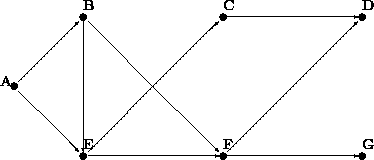I'm sure you all know the drill by now
DISCLAIMER: This TYS, and probably a few others that I'll put up, are shamelessly stolen from my own CS assignments (AFTER the assignment has been handed in, of course
PROBLEM 1: A directed graph can be represented as a list of nodes, where each node is a list consisting of a symbol (the node's name) and a list of vertices to its neighbors. For example, the following is a valid graph:
| code: |
(define Graph
'((A (B E)) (B (E F)) (C (D)) (D ()) (E (C F)) (F (D G)) (G ()))) |
And it would look like this:

Note that this is a directed graph, so the vertices have a direction; also, the graph may or may not contain cycles (this particular example doesn't, but that's no guarantee).
Write a function that takes a graph and reverses all of its vertices. (ie, if A->B before, now B->A).
For example, reverse-ing the graph we showed before should give
| code: |
'((A ())
(B (A)) (C (E)) (D (C F)) (E (A B)) (F (B E)) (G (F)))) |
Which is basically the diagram shown except with all the arrows drawn in the opposite direction.